Gennaro Cuofano's Blog, page 118
February 1, 2022
What is Bowman’s Strategy Clock And Why It Matters In Business
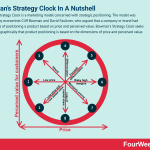
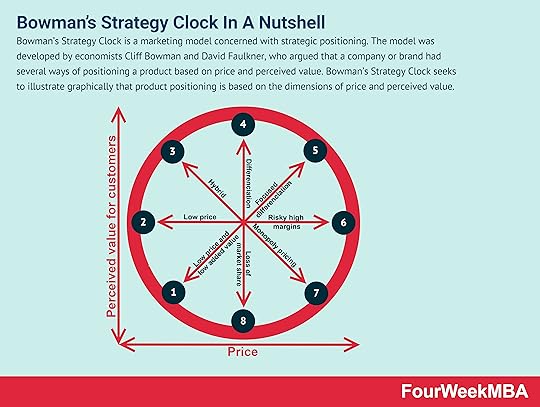
Bowman’s Strategy Clock is a marketing model concerned with strategic positioning. The model was developed by economists Cliff Bowman and David Faulkner, who argued that a company or brand had several ways of positioning a product based on price and perceived value. Bowman’s Strategy Clock seeks to illustrate graphically that product positioning is based on the dimensions of price and perceived value.
Understanding Bowman’s Strategy ClockBowman’s Strategy Clock seeks to illustrate graphically that product positioning is based on the dimensions of price and perceived value. Here, the illustration features price on the x-axis and perceived value on the y-axis.
On the graph lies the circular Bowman’s Clock. Varying combinations of price and perceived value lead to eight conceivable marketing strategies. Businesses can pick one of the eight strategies that suit them best, according to the price and perceived value of the product, service, or brand they are trying to market.
Bowman’s Strategy Clock was developed in 1996 in response to Michael Porter’s Generic Strategies, a model that explained three general ways in which a company could gain a competitive advantage. While Porter’s model was useful to some extent, some found his approach a little too generic and desired something more detailed. Cliff Bowman then developed his model to expand Porter’s idea into the various strategic options that we will discuss in the next section.
The eight strategies of Bowman’s Strategy ClockBusinesses must select one of the competitive strategies of Bowman’s Strategy Clock according to their specific needs, circumstances, and the particular barriers they are experiencing.
For example, a business that competes on price should assess whether it has price leadership and can exploit cost advantages to sustain that advantage. A business that competes on perceived value, on the other hand, should focus on understanding its target audience with respect to their needs, wants, and pain points. To effectively differentiate themselves, it is also important that they understand how the market as a whole perceives competitor products.
Now it is time to dive into each of the eight strategies.
1. Low price and low value-added.Since the first strategy involves low-value products sold at the lowest possible price, there is little scope for strategic positioning if a competitor is already selling for the lowest price possible. The consumer also perceives very little value, despite the low price, which decreases brand loyalty.
2. Low priceThe low price strategy means a product is the lowest cost option in its marketplace. Businesses who want to utilize this strategy must manufacture products in large quantities while also being cost-effective and efficient. Walmart is a classic example of a low price strategy market leader.
3. HybridIn the hybrid strategy, consumers perceive added value through a combination of competitive low pricing and product differentiation. If the added value is offered consistently, this can be an effective positioning strategy. Flatpack furniture outlet IKEA is a great example of the hybrid strategy.
4. DifferentiationThe differentiation strategy is equated with high perceived value. Because of this, brand equity is high – allowing businesses to compete in highly competitive markets. Ultimately, the consumer chooses to pay a higher price for a product they could purchase elsewhere for less. Starbucks is a company that uses the differentiation strategy to its advantage.
5. Focused differentiationFocused differentiation is where most luxury brands reside. They have extremely high perceived value and a price to match. Companies such as Rolex and Ferrari are competitive in this sphere through product promotion to their highly targeted audience. Brand equity is similarly very high.
6. Risky high marginsAs the name suggests, this is a high-risk strategy where businesses set high prices without offering much value in return. Often, they are relying on brand equity to drive sales. Inevitably, a competitor will enter the market and offer a product for similar perceived value but at a lower price. Businesses that offer gym memberships are one such example.
7. Monopoly pricingA company that enjoys a monopoly over its market is less concerned about perceived value or pricing. This is because the consumer is reliant on the business for the products and services that it offers. Thus, perceived value is often low and so too is brand equity. Despite total market share, monopolies are difficult to obtain and such companies are often dissolved by regulatory bodies. American telecommunication company AT&T is a notable recent example.
8. Loss of market shareThe loss of market share strategy involves products with low perceived value but with disproportionately high pricing. When the iPhone was first launched in 2007, it quickly rendered the dominant Blackberry obsolete. As a result, Blackberry phones lost their perceived value and market share very quickly.
Non-viable market positions in Bowman’s Strategy ClockNote that the sixth, seventh, and eighth positions are not viable strategies in competitive marketplaces.
Whenever the price of a product is greater than its perceived value, the business will find it difficult to sell its products in the face of other companies selling cheaper alternatives.
Companies that find themselves in this predicament have two options. They can either add perceptible value to the product or service on offer or increase perceived value by lowering its price. If none of these initiatives can be accomplished, the business should exit the market.
Advantages and disadvantages of Bowman’s Strategy ClockAdvantagesChoice – as noted in the introduction, Bowman’s Strategy Clock sets out a broader spectrum of strategic options for a company when compared to Porter’s Generic Strategies. This gives decision-makers more freedom of choice.Ease of use – while more detailed, Bowman’s framework is easy to understand and analyze. It provides multiple starting points for a business looking to establish and maintain a competitive advantage in a market-driven economy.DisadvantagesOne dimensional – the primary criticism of Bowman’s Strategy Clock is that it fails to account for firms that occupy more than one strategic position at the same time. Since the model is focused on developing a sustainable competitive advantage, the business in a market characterized by low competition will need to look elsewhere to define a strategy.Differentiation – each of the eight strategic positions of the model is represented in a circle divided into segments, not unlike the face of a clock. However, the boundaries between each position are somewhat blurred and may be difficult to understand as a result.Key takeaways:Bowman’s Strategy Clock is a marketing model that investigates how a product might be positioned to give it a maximum competitive advantage. It is a more detailed framework that seeks to build on the somewhat more generic Porter’s Generic Strategies approach. Bowman’s Strategy Clock features eight possible competitive strategies that apply to different markets and products.Of the eight different strategies, three are associated with undesirable market positioning. Nevertheless, many businesses find themselves in these positions and must find ways to increase the perceived or actual value of their products.Read also: Business Strategy, Examples, Case Studies, And ToolsOther strategy frameworksPorter’s Five ForcesAnsoff MatrixBlitzscaling CanvasBusiness Analysis FrameworkGap AnalysisBusiness Model CanvasLean Startup CanvasDigital Marketing CircleBlue Ocean StrategyMore resources:
What Is Business Model InnovationWhat Is a Business ModelWhat Is Business StrategyWhat Is a Value PropositionWhat Is Market SegmentationWhat Is a Marketing StrategyThe post What is Bowman’s Strategy Clock And Why It Matters In Business appeared first on FourWeekMBA.
The Occam’s Razor In A Nutshell
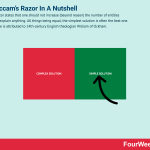
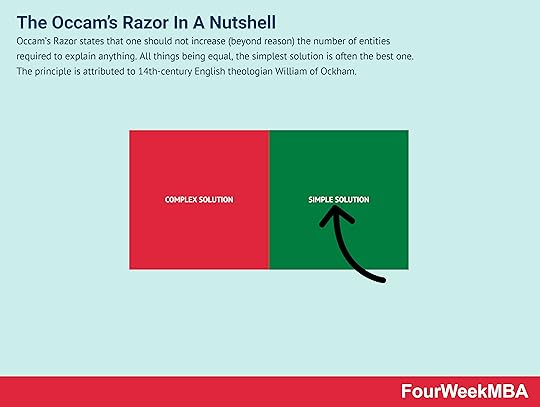
Occam’s Razor states that one should not increase (beyond reason) the number of entities required to explain anything. All things being equal, the simplest solution is often the best one. The principle is attributed to 14th-century English theologian William of Ockham.
Understanding Occam’s RazorOccam’s Razor is a principle that states that one should not increase (beyond reason) the number of entities required to explain anything. In other words, with all things being equal, the simplest solution is often the best one. The principle is attributed to 14th-century English theologian William of Ockham.
It’s important to realize that Occam’s Razor is not 100% reliable. That is, the simplest solution is not always the correct solution. But when a business is presented with several solutions to a problem, its best course of action is to choose the solution with the fewest assumptions.
In business, companies spend vast amounts of time and money recruiting new customers and retaining them as loyal followers. Consumers themselves are bombarded with messages daily and are easily distracted by social media and other sources of cognitive overload. While complex marketing strategies may be somewhat effective in attracting customers, far simpler solutions help businesses retain them.
Here, the simplest solution for the business is to focus on:
Product quality. Many businesses equate the number of features with the value of a product. But they do not ask the customer what they value beforehand. Products with too many features distract a consumer and reduce product utility. Occam’s Razor suggests that product development teams discard as many features as possible and go for the simplest, most effective solution.Customer service. Simplifying customer services means removing as many barriers as possible. It might be streamlining the customer purchase journey by removing unnecessary sign-up forms. It might also mean removing wait times on customer support calls. Ultimately, consumer behavior is guided by simplicity and a pleasurable shopping experience.Defining their target audience. No product or business can appeal to everyone, so defining a target audience should be made as simple as possible. Simplicity is achieved by starting small and focusing on the traits of a single, ideal customer to develop a marketing persona.This is Occam’s Razor at work. Simplifying procedures increases productivity and profitability by focusing on processes most likely to deliver results.
Examples of Occam’s Razor in companiesMcDonald’sIn an attempt to boost their profits, McDonald’s created the now-infamous phrase “Would you like fries with that?” Behind this catchphrase, marketers selected a very simple way to increase profits out of what was likely a large spread of options. Fries are of course made with potatoes, which are cheap and abundant and thus very profitable.
AppleWhile the removal of the headphone jack may have been a case of over-simplification, the design of the iPhone also reflects Occam’s Razor principles. With just a single button on smartphones and tablet devices, designers gave consumers a sleek and minimalist product without extraneous features.
Where can Occam’s razor be applied in business?In this section, we’ll detail the ways Occam’s Razor can be applied in business to reduce complexity in certain situations.
Too many websitesSome business owners create a separate website for each of their brands with the belief that more sites equal more sales. However, this does not tend to be the case. Operating a single website is much simpler and more efficient. It is also much more cost-effective since hosting and maintenance costs are reduced.
In the context of marketing, too many websites means finite resources must be spread and diluted in the process. Aside from poor resource utilization, this also reduces an individual website’s ability to dominate its niche and be ranked on the first page of search results.
Other companies dilute their presence with different websites for their B2B and B2C operations. Unless there is a valid reason for doing so, these models should not be separated as doing so only leads to cost increases. Instead, it is better to keep it simple by creating a website that appears for all intents and purposes to be a B2C site. B2B customers can use the site by accessing a password-protected area where they can see a list of business prices, make volume purchases, or contact a dedicated support team, for example.
Bloated proposalsThe most persuasive business proposals are those that focus on a simple minimum viable product (MVP).
 A leaner MVP is the evolution of the MPV approach. Where the market risk is validated before anything else
A leaner MVP is the evolution of the MPV approach. Where the market risk is validated before anything elseWhy is this the case? For one, simple MVPs tend to be cheaper and as a result, are associated with less risk. They can also be developed more rapidly, which shortens the time until the company can enter the market.
Despite these benefits, some product developers choose to ignore Occam’s Razor and develop complicated, bloated proposals where an excess of bells and whistles is the norm. The goal here should be to work with the customer and assess each feature on its own merits to determine whether it contributes to functionality. Superfluous features that do nothing but add complexity to the MVP should be discarded.
International expansionBusiness owners can also become preoccupied with complexity when looking to expand into international markets. An eCommerce site looking to sell tennis rackets in France and Spain, for example, may feel the need to replicate their website on a .fr and .es domain. However, this situation is similar to building a separate website for each brand. That is, it tends to be more expensive, more inefficient, and less effective in terms of SEO.
For most eCommerce companies, a simpler course of action involves using canonical link elements for each country on their core website. For example, tennis rackets for sale in France may be found at tennisrackets.com/fr/ and in Spain at tennisrackets.com/es/.
While a .fr site written in French may convert higher, a separate French page on the core tennisrackets.com domain will be effective provided it prices the tennis rackets in euros and details country-specific shipping policies. In fact, any decrease in conversation rate is normally offset by reduced maintenance costs and the increased authority and visibility of the tennisrackets.com domain.
Key takeaways:Occam’s Razor says that the simplest solution is more likely to be the correct solution. The theory does not provide the correct solution 100% of the time, but it does posit that a simpler solution with fewer variables yields more predictable results and is easier for the business to execute.Occam’s Razor helps businesses focus on streamlining product development, simplifying customer service, and defining a target audience. McDonald’s and Apple are two examples of companies that have used simplicity to their advantage.In more general business applications, Occam’s Razor is used to reduce the complexity that arises from too many websites, bloated product proposals, and international expansion efforts.Learn also:
Speed-Reversibility MatrixGrowth-Share MatrixAnsoff MatrixDigital Strategy MatrixLearn more:
Distribution ChannelsTypes of Business Models You Need to KnowBusiness Strategy: Definition, Examples, And Case StudiesMarketing Strategy: Definition, Types, And ExamplesPlatform Business Models In A NutshellNetwork Effects In A NutshellGross Margin In A NutshellThe post The Occam’s Razor In A Nutshell appeared first on FourWeekMBA.
3C Analysis Business Model In A Nutshell
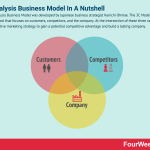
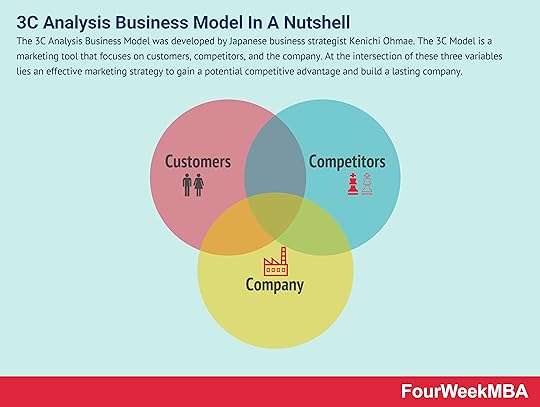
The 3C Analysis Business Model was developed by Japanese business strategist Kenichi Ohmae. The 3C Model is a marketing tool that focuses on customers, competitors, and the company. At the intersection of these three variables lies an effective marketing strategy to gain a potential competitive advantage and build a lasting company.
Understanding the 3C Analysis Business ModelThe 3C analysis business model was developed by Japanese business strategist and organizational theorist Kenichi Ohmae in 1982.
The model first appeared in Ohmae’s book The Mind of the Strategist: The Art of Japanese Business, where he discussed the thinking processes and planning techniques of some of the world’s most successful companies.
The book was well-received for its ability to empower modern decision-makers to be courageous, innovative, problem-solvers. Indeed, Harvard Business School Professor Michael Porter said that Ohmae’s book was “A fascinating window into the mind of one of Japan’s premier strategists…full of ideas about how to improve strategic thinking.”
In essence, Ohmae posited that business success was based on a mix of:
The needs of the customer.The strengths of the corporation, andThe products and services offered by competitors.When a firm takes the time to integrate all three components in harmony, it can then develop a sustainable competitive advantage. However, when one of these components is not in balance, the success of the company may be jeopardized.
In the following sections, we’ll take a look at customers, corporations, and competitors in more detail.
CustomersCustomers are the most important of the three components, for without customers there can be no company nor any way to gain a competitive advantage. Ohmae believed that customers were the foundation for any strategy and that the goal of any business should be to support the interests of the customer and not shareholders, for example.
Businesses must know their customers intimately so that their marketing strategies resonate with them on a meaningful level. This starts with research and a few questions such as:
What is the demographic of the target audience? In other words, who are the customers that a business wants to target? Why do they make buying decisions? Are they motivated by value, economy, or status? What other problems might they be trying to solve?What are the different segments of a target audience and how might be they marketed to effectively? For example, a consumer who drinks coffee to stay awake will need a different strategy than one who drinks it socially in a café. CompetitorsA business must know where it stands in relation to its competitors. Is it bigger? Smaller? Is the competition trying to take market share from the business, or is the opposite true?
According to Ohmae, competitor-based marketing strategies involve looking for a point of difference in purchasing, engineering, sales, or servicing.
This can be achieved in several ways:
Investing in brand imageOhmae noted that companies such as Sony and Honda were able to sell more than their competitors in the Japanese market because of heavy investment in advertising and consumer relations.
Hito-kane-monoJapanese business planners believe in the concept of hito-kane-mono, loosely translated as people, money, and things (assets). As a point of competitive differentiation, businesses can ensure these resources are in balance without waste or surplus. For example, managers who are given more money than they can competently spend tend to waste that money unnecessarily. In this case, Ohmae argues that managers should first define their ideas and then adapt a budget to suit.
Profit and cost-structure differencesDifferent sources of profit can also be exploited, such as the profit seen in new product sales or value-adding services. Large companies with lower fixed-cost ratios can also lower their prices in a stagnant market to gain market share.
CompanyThe company itself must also look inwardly to design strategies aimed at maximizing strengths relative to the competition. This involves a combination of short and long-term strategies, including:
SpecializationA business should always identify one or two areas of expertise, instead of trying to specialize in everything.
Produce or procureIn terms of manufacturing, a business has two options. It can take advantage of backward integration and take control of its supply chain in the process. Or, it can outsource non-value-adding activities to a third party.
Cost-effectivenessThis is a relatively simple way of gaining a competitive advantage. Businesses can reduce basic operating costs by focusing on processes that have the highest potential for automation or streamlining. Longer-term, businesses can combine resources and knowledge with others in their industry to develop a competitive advantage.
Interpreting the 3C analysisInterpreting the 3C analysis means taking a look at how each circle overlaps and interacts with the other circles. To better understand these interactions, we have provided a basic explanation of each below:
Customer/company overlapThis provides a competitive advantage in the market where a product is positively perceived by consumers who are more importantly willing to pay for it.
Customer/company/competition overlapAt the intersection of all three circles there is likely to be a price war. In other words, there is little differentiation between the products and services of one company and alternatives from another. With consumers unable differentiate a value proposition, a price war may ensue.
Customer/competition overlapAn undesirable situation where consumers prefer the products and services of a competitor and are willing to pay for them.
Competition/company overlapWhen the circles representing competition and company intersect, this may signify an illegal price-fixing situation.
Implementing the 3C analysisFor best results, decision-makers must not attempt to implement each of three components simultaneously. Aside from the unnecessary stress and logistical issues that may arise, a better approach is to focus on the customers first and work from there. Making customers a priority does not mean shareholders are rejected. In fact, a company that has authentic interest in its customers will find that shareholder interests are taken care of automatically.
Once the needs, wants, and demands of the consumer have been identified, the business should then concern itself with other matters. In other words, how does the consumer base perceive its products and services? How does it perceive competitor products? This provides insight into what the competition is capable of doing in the market.
From there, the business must direct resources in such a way that its strengths are maximized and competitive advantage is created. For the model to be effective, it is important to note that the business does not need to excel in every area. It can start with a decisive edge in just one key function and then set about enhancing the other functions.
The 3C model is not complex or convoluted, but it does encourage decision-makers to simplify operations by focusing on customers, competitors, and the corporation at all times.
Key takeaways:The 3C Analysis Business Model suggests a business focuses on three key factors for success – company, customer, and the competition.The strengths of the 3C Analysis Business Model lie in its simplicity, practicality, and emphasis on efficiency to reduce wastage.Customers are crucial to the success of the 3C Analysis Business Model, dictating the strategies formulated for competitors and the company.Read also: Business Models, Business Strategy, Examples, Case Studies, And ToolsRelated Business FrameworksTechnological Modeling Technological modeling is a discipline to provide the basis for companies to sustain innovation, thus developing incremental products. While also looking at breakthrough innovative products that can pave the way for long-term success. In a sort of Barbell Strategy, technological modeling suggests having a two-sided approach, on the one hand, to keep sustaining continuous innovation as a core part of the business model. On the other hand, it places bets on future developments that have the potential to break through and take a leap forward. Business Model Wheel
Technological modeling is a discipline to provide the basis for companies to sustain innovation, thus developing incremental products. While also looking at breakthrough innovative products that can pave the way for long-term success. In a sort of Barbell Strategy, technological modeling suggests having a two-sided approach, on the one hand, to keep sustaining continuous innovation as a core part of the business model. On the other hand, it places bets on future developments that have the potential to break through and take a leap forward. Business Model Wheel A business model wheel provides a structured approach to defining a business model. Each model wheel is broken down into three core components: offering, monetization and sustainability. Each component in turn contributes to a total of eight areas that make up an ideal business model.Tech Business Model Framework
A business model wheel provides a structured approach to defining a business model. Each model wheel is broken down into three core components: offering, monetization and sustainability. Each component in turn contributes to a total of eight areas that make up an ideal business model.Tech Business Model Framework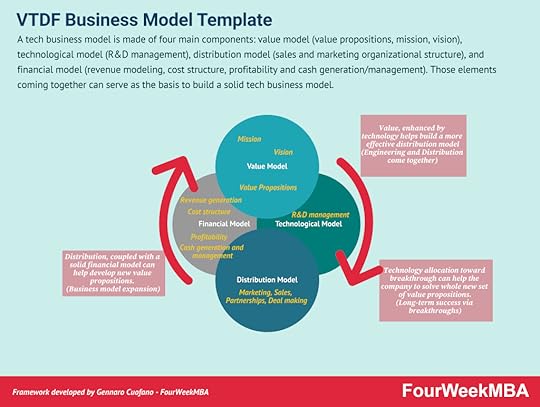 A tech business model is made of four main components: value model (value propositions, mission, vision), technological model (R&D management), distribution model (sales and marketing organizational structure), and financial model (revenue modeling, cost structure, profitability and cash generation/management). Those elements coming together can serve as the basis to build a solid tech business model.Blockchain Business Models Framework
A tech business model is made of four main components: value model (value propositions, mission, vision), technological model (R&D management), distribution model (sales and marketing organizational structure), and financial model (revenue modeling, cost structure, profitability and cash generation/management). Those elements coming together can serve as the basis to build a solid tech business model.Blockchain Business Models Framework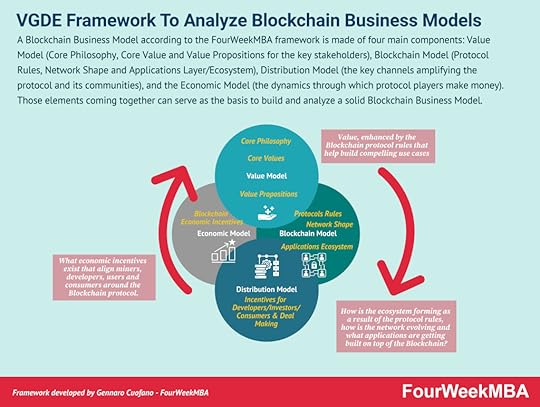 A Blockchain Business Model according to the FourWeekMBA framework is made of four main components: Value Model (Core Philosophy, Core Value and Value Propositions for the key stakeholders), Blockchain Model (Protocol Rules, Network Shape and Applications Layer/Ecosystem), Distribution Model (the key channels amplifying the protocol and its communities), and the Economic Model (the dynamics through which protocol players make money). Those elements coming together can serve as the basis to build and analyze a solid Blockchain Business Model.Other strategy frameworksPorter’s Five ForcesAnsoff MatrixBlitzscaling CanvasBusiness Analysis FrameworkBusiness Model CanvasBlue Ocean Strategy
A Blockchain Business Model according to the FourWeekMBA framework is made of four main components: Value Model (Core Philosophy, Core Value and Value Propositions for the key stakeholders), Blockchain Model (Protocol Rules, Network Shape and Applications Layer/Ecosystem), Distribution Model (the key channels amplifying the protocol and its communities), and the Economic Model (the dynamics through which protocol players make money). Those elements coming together can serve as the basis to build and analyze a solid Blockchain Business Model.Other strategy frameworksPorter’s Five ForcesAnsoff MatrixBlitzscaling CanvasBusiness Analysis FrameworkBusiness Model CanvasBlue Ocean StrategyMore resources:
What Is Business Model InnovationWhat Is a Business ModelWhat Is a Value PropositionWhat Is Market SegmentationWhat Is a Marketing StrategyThe post 3C Analysis Business Model In A Nutshell appeared first on FourWeekMBA.
January 30, 2022
Vroom-Yetton Decision Model Explained
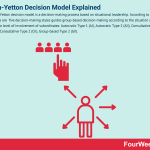

The Vroom-Yetton decision model is a decision-making process based on situational leadership. According to this model, there are five decision-making styles guides group-based decision-making according to the situation at hand and the level of involvement of subordinates: Autocratic Type 1 (AI), Autocratic Type 2 (AII), Consultative Type 1 (CI), Consultative Type 2 (CII), Group-based Type 2 (GII).
Understanding the Vroom-Yetton decision modelThe Vroom-Yetton decision model was created by Victor Vroom with subsequent input from Phillip Yetton in 1973 and Arthur Jago in 1988.
Vroom, a business school professor at the Yale School of Management, developed the model based on a passion for discovering why subordinates follow a specific course of action and prefer some outcomes over others in organizations. To that end, the model is based on a situational leadership theory that is itself based on organizational and industrial psychology.
Vroom and Yetton argued that the participation of subordinates in decision-making was one of the most persistent and controversial issues in business management.
In response to this issue, the Vroom-Yetton decision model was created. The model defines circumstances in which subordinate participation in decision-making either benefits or hinders organizational effectiveness.
Based on empirical evidence, the model advocates a set of guidelines governing the extent of subordinate involvement in decision-making. The model suggests that good decision-making is based on context and that not all decisions are created equal. This requires the leader to adapt their behavior based on the level of subordinate participation.
The three factors of the Vroom-Yetton modelFirst, the model asks decision-makers to consider three specific factors that relate to the decision that needs to be made. The individual who takes the time to assess these factors in detail will be rewarded with a clear plan of action.
Now let’s take a look at each factor:
Decision qualityHow critical is it to arrive at the correct decision? While the business should always strive to make the right choice, some choices are more important than others. The commitment of vast amounts of resources to every decision is simply not feasible, so the business must pick and choose its battles, as it were.
Subordinate commitmentSome decisions will impact subordinates in some way, while other decisions will have very little to do with them. Leaders must assess the impact of a decision on subordinates and the organization as a whole. To increase buy-in, subordinates should always be involved in decisions that impact them.
Time constraintsWhen making a decision, an accurate timeline should first be created to determine whether there is time to include others or research potential solutions in detail beforehand.
Assessing the organizational effectiveness of decision makingTo determine the influence the above three factors will have on the decision at hand, decision-makers should ask themselves the following questions in the sequence they are presented:
Quality requirement (QR) – is the nature of the solution critical? Does a solution need to be chosen based on technical, rational, or quality-based grounds?Commitment requirement (CR) – how important is the commitment of subordinates to the decision?Leader’s information (LI) – is there sufficient information for a leader to make a good decision on their own?Problem structure (ST) – is the problem structured? Do alternative courses of action exist? Can these alternatives be evaluated accurately? Is the problem defined, clear, or time-limited?Commitment probability (CP) – is subordinate acceptance integral to the implementation of the solution? In other words, would they be committed to a unilateral decision?Goal congruence (GC) – are subordinates invested in the solution? Do their goals match the goals of the organization?Subordinate conflict (CO) – is there likely to be conflict among subordinates over preferred courses of action?Subordinate information (SI) – lastly, do these subordinates have the requisite information to make an informed, high-quality decision?Using simple yes or no answers, the decision-maker uses a decision tree to then land on one of five different decision-making options across three different leadership styles.
The five decision-making styles of the Vroom-Yetton modelOnce a decision-making option has been identified, the Vroom-Yetton model explains how each leadership style influences the decision-making process. Below we will take a look at how this process plays out in practice.
AutocraticThe autocratic leader makes a decision and tells subordinates after the fact. They use the information at hand to decide on a course of action they deem most appropriate.
The two autocratic options are:
Autocratic Type 1 (AI) – a completely autocratic process where the leader makes their own decision based on readily available information.Autocratic Type 2 (AII) – where the leader collects information from subordinates and then makes a decision alone. Subordinates may or may not be notified after the fact.ConsultativeThink of consultative leadership as a lite version of autocratic leadership. Leaders will ultimately make decisions on their own but will first consult with subordinates to hear their input and opinions.
In the Vroom-Yetton model, there are also two consultative options:
Consultative Type 1 (CI) – where the leader consults with subordinates on an individual basis to collect information and facilitate input. However, note that there is no requirement for the input to be used to make the final decision. Individual employees do not consult amongst themselves.Consultative Type 2 (CII) – in this case, individuals can consult each other and share possible alternatives. But again, the leader is under no obligation to incorporate collective input into the final decision.CollaborativeAs the name suggests, collaborative leadership involves the leader working with subordinates to choose a group. This is a more time-intensive decision-making approach and should be used for important decisions that do not need to be made immediately.
There is a single collaborative option:
Group-based Type 2 (GII) – where the leader looks to the group for consensus via brainstorming and the final decision is made collectively. While the leader is responsible for directing the discussion, they must not under any circumstances try to force their own agenda on subordinates. Key takeaways:The Vroom-Yetton decision model is a decision-making tool based on situational leadership.The Vroom-Yetton decision model is based on empirical evidence suggesting that the extent of subordinate participation in decision-making impacts organizational effectiveness.To progress through the Vroom-Yetton decision model, decision-makers (leaders) must use a decision tree containing seven questions with yes or no answers. Depending on the answers given, they will eventually arrive at one of five decision-making styles.Main Free Guides:
Business ModelsBusiness StrategyBusiness DevelopmentDigital Business ModelsDistribution ChannelsMarketing StrategyPlatform Business ModelsTech Business ModelThe post Vroom-Yetton Decision Model Explained appeared first on FourWeekMBA.
What Is A Linear Model Of Communication? The Linear Model Of Communication In A Nutshell
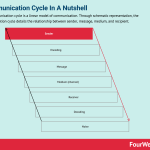

The linear model of communication is a relatively simplistic model envisaging a process in which a sender encodes and transmits a message that is received and decoded by a recipient. The linear model of communication suggests communication moves in one direction only. The sender transmits a message to the receiver, but the receiver does not transmit a response or provide feedback to the sender.
Understanding linear models of communicationThe linear model of communication is a relatively simplistic model envisaging a process in which a sender encodes and transmits a message that is received and decoded by a recipient.
Linear communication models are especially useful in customer-centric business activities such as marketing, sales, public relations, and broadcast advertising. In fact, linear models may be effective in any scenario where message feedback from the recipient is quite separate from the initial communication itself.
These models also help companies determine how their promotional messages may be altered by their encoding process, choice of the transmission medium, and any potential noise interference.
The Shannon-Weaver model, the basis for all modern communication models, considers the communication process to be linear and one-way. Developed in 1949 by Claude Shannon and Warren Weaver, it consists of six elements:
Sender (information source) – the person who starts the communication process by transmitting information.Encoder (transmitter) – the person or machine responsible for converting the information into a signal that can be understood by the receiver. In Shannon and Weaver’s day, one-way communication was the norm and occurred mostly via telegraph and radio.Channel (medium) – or the infrastructure supporting the transmission of the message from sender to receiver. An individual sending an email is using the internet as their channel.Noise – or any factor responsible for the information being misinterpreted, categorized according to whether it is internal or external. Internal noise is the result of the sender making a mistake, such as a misspelled word in a text message. External noise occurs when something outside the control of the sender or receiver impedes the message. Two people attempting to have a conversation at a loud rock concert is one example.Decoder – in most cases, a device that decodes the encoded message sent by the sender into a format that is understandable for the receiver. Today, this device is usually a smartphone.Receiver (destination) – the receiver is the person who receives the information transmitted by the sender. Other linear communication modelsIn this section, let’s take a look at some other linear communication models.
Aristotle’s model The Aristotle model of communication is a linear model with a focus on public speaking. The Aristotle model of communication was developed by Greek philosopher and orator Aristotle, who proposed the linear model to demonstrate the importance of the speaker and their audience during communication.
The Aristotle model of communication is a linear model with a focus on public speaking. The Aristotle model of communication was developed by Greek philosopher and orator Aristotle, who proposed the linear model to demonstrate the importance of the speaker and their audience during communication. Although the Shannon-Weaver model was one of the first modern communication frameworks, Greek philosopher Aristotle proposed a similar model around 300 B.C. Aristotle focused on public speaking as opposed to interpersonal communication.
As a result, the Aristotle model of communication can be broken down into five broad elements:
Speaker – the individual delivering the message.Speech – the information that is communicated.Occasion – the context of the communication. For example, the occasion of a politician delivering an address to votes may be an imminent election.Audience – a collection of individuals who passively receive the information that is transmitted.Effect – the intention of the speaker. In the case of a politician, their communication intends to persuade voters to vote for them.Since Aristotle’s model is speaker-centric, it also details three elements that are essential to effective public speaking. These relate to credibility, authority, and an ability to connect with the audience on an emotional level. The speaker must also be able to support their statements with relevant facts and data.
Berlo’s SMCR modelBerlo’s SMCR model was developed by American communication theorist David Berlo in 1960. Berlo took the Shannon-Weaver model and expanded it into several clear and distinct components. He saw communication as a linear process that was only successful when the skills of the person receiving the message complemented (or were equal to) those of the sender.
There are four elements to the model which comprise the SMCR acronym:
Source/sender (S) – where the message originates. The source is impacted by factors such as communication skills, knowledge, culture, social system, and attitude.Message (M) – the information that is sent from the sender to the receiver. Message factors include content, elements (language, gesturing), treatment (how the message is conveyed), and structure. Code, or the means through which the message is sent and in what form, is also important. For the message to be clear, the code must be clear.Channel (C) – in Berlo’s model, a channel refers to the five senses: hearing, seeing, smelling, tasting, and touching. Most messages are heard or seen, but the other senses are also important.Receiver (R) – the individual who receives the message. For the message to be understood correctly, the receiver must possess comparable traits in terms of culture, social system, attitude, knowledge, or skill.Lasswell’s communication modelLasswell’s communication model was created by Harold Lasswell, a political scientist and communication theorist.
 The Lasswell communication model is a linear framework for explaining the communication process through segmentation. Lasswell proposed media propaganda performs three social functions: surveillance, correlation, transmission. Lasswell believed the media could impact what viewers believed about the information presented.
The Lasswell communication model is a linear framework for explaining the communication process through segmentation. Lasswell proposed media propaganda performs three social functions: surveillance, correlation, transmission. Lasswell believed the media could impact what viewers believed about the information presented. Lasswell’s model describes the communication process by asking the following questions:
Who? – this may be a person or institution in a position of authority.Says what? – the message that is communicated, such as a news story, political story, or some other story with a hero, villain, and important theme.In which channel? – such as television, radio, magazines, letters, or photography.To whom? – the receiver of the message. Lasswell noted that this encompassed citizens, newspaper readers, or specific segments such as children, adults, or women.With what effect? – or the context-dependent feedback the receiver sends to the sender.The model was initially created to analyze mass communication by the media and the role that media propaganda plays in society. However, it can also be used for interpersonal communication or in any situation where information is disseminated to groups. In this way, Lasswell’s model incorporates aspects of non-linear communication.
Criticisms of linear models of communicationAlthough straightforward and easy to understand, there are obvious limitations to linear models of communication.
Communication theories proposed by Shannon and Weaver assume communication to be a one-way process where each person takes turns sending and receiving information. Modern scholars, however, tend to agree that communication is a more complicated and dynamic process where both individuals embody the sender and receiver role simultaneously.
This is especially true during face-to-face conversations, where body language and gesturing complements spoken language as a means of transmitting messages. Theorist Norbert Weiner later added a seventh element to the Shannon-Weaver model to describe feedback, or the receiver’s interpretation of the transmitted message sent back to the sender. However, some saw this addition as an afterthought since the concept of feedback was foreign to Weaver when he developed the model.
Furthermore, linear models fail to consider how context or an individual’s personal experiences impact communication. Some people may shout at the television during a sporting match based on their personality and unique life experiences, while others may react calmly to the same footage. Of course, the television broadcaster transmitting the message is doing so to a large number of receivers and cannot possibly cater to them all.
Laswell’s model of communication, another linear communication model, seeks to address this limitation by deconstructing the elements of mass communication into five distinct components. These components help the receiver decipher the meaning of the message sent and the intention of the individual or company sending it.
Key takeaways:Linear models of communication suggest communication moves in one direction only. The sender transmits a message to the receiver, but the receiver does not transmit a response or provide feedback to the sender.The first linear model of communication was the Shannon-Weaver model. The six elements that describe the one-way communication process are sender, encoder, channel, noise, decoder, and receiver.There are several limitations to linear communication models. For one, they ignore the fact that communication is a dynamic process where both individuals embody the sender and receiver roles simultaneously. They also ignore non-verbal forms of communication in face-to-face conversation and how messages are interpreted when there is one sender and multiple receivers.Connected Business Frameworks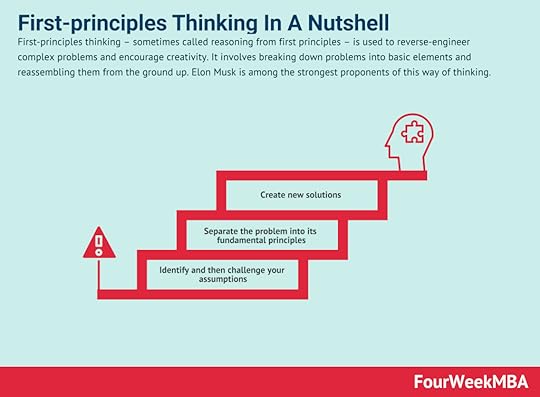 First-principles thinking – sometimes called reasoning from first principles – is used to reverse-engineer complex problems and encourage creativity. It involves breaking down problems into basic elements and reassembling them from the ground up. Elon Musk is among the strongest proponents of this way of thinking.
First-principles thinking – sometimes called reasoning from first principles – is used to reverse-engineer complex problems and encourage creativity. It involves breaking down problems into basic elements and reassembling them from the ground up. Elon Musk is among the strongest proponents of this way of thinking. The ladder of inference is a conscious or subconscious thinking process where an individual moves from a fact to a decision or action. The ladder of inference was created by academic Chris Argyris to illustrate how people form and then use mental models to make decisions.
The ladder of inference is a conscious or subconscious thinking process where an individual moves from a fact to a decision or action. The ladder of inference was created by academic Chris Argyris to illustrate how people form and then use mental models to make decisions. The Six Thinking Hats model was created by psychologist Edward de Bono in 1986, who noted that personality type was a key driver of how people approached problem-solving. For example, optimists view situations differently from pessimists. Analytical individuals may generate ideas that a more emotional person would not, and vice versa.
The Six Thinking Hats model was created by psychologist Edward de Bono in 1986, who noted that personality type was a key driver of how people approached problem-solving. For example, optimists view situations differently from pessimists. Analytical individuals may generate ideas that a more emotional person would not, and vice versa. Second-order thinking is a means of assessing the implications of our decisions by considering future consequences. Second-order thinking is a mental model that considers all future possibilities. It encourages individuals to think outside of the box so that they can prepare for every and eventuality. It also discourages the tendency for individuals to default to the most obvious choice.
Second-order thinking is a means of assessing the implications of our decisions by considering future consequences. Second-order thinking is a mental model that considers all future possibilities. It encourages individuals to think outside of the box so that they can prepare for every and eventuality. It also discourages the tendency for individuals to default to the most obvious choice.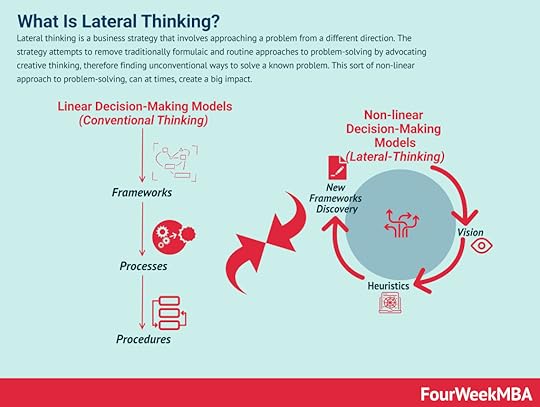 Lateral thinking is a business strategy that involves approaching a problem from a different direction. The strategy attempts to remove traditionally formulaic and routine approaches to problem-solving by advocating creative thinking, therefore finding unconventional ways to solve a known problem. This sort of non-linear approach to problem-solving, can at times, create a big impact.
Lateral thinking is a business strategy that involves approaching a problem from a different direction. The strategy attempts to remove traditionally formulaic and routine approaches to problem-solving by advocating creative thinking, therefore finding unconventional ways to solve a known problem. This sort of non-linear approach to problem-solving, can at times, create a big impact. Moonshot thinking is an approach to innovation, and it can be applied to business or any other discipline where you target at least 10X goals. That shifts the mindset, and it empowers a team of people to look for unconventional solutions, thus starting from first principles, by leveraging on fast-paced experimentation.
Moonshot thinking is an approach to innovation, and it can be applied to business or any other discipline where you target at least 10X goals. That shifts the mindset, and it empowers a team of people to look for unconventional solutions, thus starting from first principles, by leveraging on fast-paced experimentation. Tim Brown, Executive Chair of IDEO, defined design thinking as “a human-centered approach to innovation that draws from the designer’s toolkit to integrate the needs of people, the possibilities of technology, and the requirements for business success.” Therefore, desirability, feasibility, and viability are balanced to solve critical problems.
Tim Brown, Executive Chair of IDEO, defined design thinking as “a human-centered approach to innovation that draws from the designer’s toolkit to integrate the needs of people, the possibilities of technology, and the requirements for business success.” Therefore, desirability, feasibility, and viability are balanced to solve critical problems. The CATWOE analysis is a problem-solving strategy that asks businesses to look at an issue from six different perspectives. The CATWOE analysis is an in-depth and holistic approach to problem-solving because it enables businesses to consider all perspectives. This often forces management out of habitual ways of thinking that would otherwise hinder growth and profitability. Most importantly, the CATWOE analysis allows businesses to combine multiple perspectives into a single, unifying solution.
The CATWOE analysis is a problem-solving strategy that asks businesses to look at an issue from six different perspectives. The CATWOE analysis is an in-depth and holistic approach to problem-solving because it enables businesses to consider all perspectives. This often forces management out of habitual ways of thinking that would otherwise hinder growth and profitability. Most importantly, the CATWOE analysis allows businesses to combine multiple perspectives into a single, unifying solution.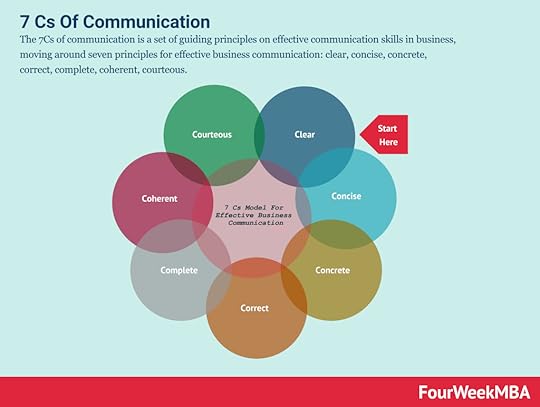 The 7Cs of communication is a set of guiding principles on effective communication skills in business, moving around seven principles for effective business communication: clear, concise, concrete, correct, complete, coherent, courteous.
The 7Cs of communication is a set of guiding principles on effective communication skills in business, moving around seven principles for effective business communication: clear, concise, concrete, correct, complete, coherent, courteous. Read More:
Business ModelsBusiness StrategyMarketing StrategyBusiness Model InnovationPlatform Business ModelsNetwork Effects In A NutshellDigital Business ModelsThe post What Is A Linear Model Of Communication? The Linear Model Of Communication In A Nutshell appeared first on FourWeekMBA.
What Is The Helical Model Of Communication? The Helical Model Of Communication In A Nutshell
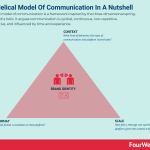

The helical model of communication is a framework inspired by the three-dimensional spring-like curve of a helix. It argues communication is cyclical, continuous, non-repetitive, accumulative, and influenced by time and experience.
Understanding the helical model of communicationThe helical model of communication was first proposed by Frank Dance in 1967 to offer a more detailed look at the communication process. Dance equated the functioning of his model with a helix or spiraling curve shaped like a spring that moves upward and downward.
To better explain the helical aspect of the model, Dance argued that an individual begins communicating from the day they are born by crying for whatever they need. This is a simple and very rudimentary form of communication. As they grow older, the child progresses to more complex forms of communication which are also cumulative. When they graduate from single words to complete sentences, they are building on what they already know to communicate more effectively.
This process is represented by a helix, with progressively larger circles providing a visual metaphor for the evolution of communication from birth to the present moment. It’s also important to note that communication moves backward in the metaphorical sense. The child who learns to speak in complete sentences is drawing on memories and impressions from an earlier period in their life.
This process of looking backward also shapes behavior. For example, a teenager may alter their communication style to avoid swearing after being reprimanded by a parent in the past. Two people in a romantic relationship may also alter the communication style based on previous arguments or outdated ways of communicating.
The key ideas of the Helical model of communicationHere are some of the key ideas of Dance’s model:
Communication occurs cyclically without ever perfectly repeating itself. When an individual receives information from someone, they will use it to communicate more effectively next time.The model accounts for the dimension of time in communication to suggest how an individual improves. Instead of communication being a two-dimensional process, it is in fact a three-dimensional process. Complex communication grows from simple origins. Although we touched on this concept in the introduction, the cumulative way communication evolves is worth reiterating. Two strangers may meet each other and initially exchange names and occupations to start the communication process. Over time, however, they learn to communicate through more complex channels such as body language, moods, gestures, or mannerisms.Helical model of communication advantagesIn this section, we’ll briefly discuss some of the model’s main advantages over similar communication frameworks:
VersatilityThe Helical model can be used to represent communication in a range of scenarios. These include the act of learning a language or how two people alter their interactions with increasing familiarity. To some extent, Dance’s model can also be used to explain a simple two-way conversation between individuals.
TimeThe Helical model of communication is one of the only such models to account for time and the role it plays in the communication process. Time is most associated with learning, evolution, and increasing complexity.
InterconnectednessDance also considered the impact of current experiences on future actions. Most communication models only consider past experiences in the context of feedback.
Limitations of the Helical model of communicationThe helical model of communication does possess some limitations.
While similar frameworks such as the Osgood-Schramm and Lasswell models include clear communication steps, Dance’s interpretation does not outline the processes that are inherent to a cyclical model. This makes it difficult to validate. There is also debate as to whether the helix shows communication as an evolving ability or as the learning that occurs via the act of communicating itself.
Lastly, the Helical model considers communication to be a continuous process. In reality, however, life is far from linear. Most will be able to appreciate that life is interspersed with meaningless or unproductive periods where we do not learn from our past or indeed incorporate more complex forms of communicating.
Modern applications of Dance’s modelModern applications of Dance’s communication model have been used to describe how societies evolve into knowledge economies.
Instead of the single helix that Dance used, these interpretations include a five helix model which starts with linear communication between academic circles and entrepreneurs. As information and communication technologies develop over time, the role of knowledge in society becomes more complex and widespread.
Following is a general look at each helix involved in this evolutionary process:
First helix (academia, universities)The first helix acknowledges that universities, students, researchers, and academic entrepreneurs are responsible for creating new knowledge and technology. That is, they comprise the foundational or generative aspect of a knowledge-based economy.
Second helix (academia, industry, business)This helix consists of the creative economy and similar industries where knowledge can be utilized to create innovations via research and development.
Third helix (academia, industry, government)For a knowledge economy to exist, there must be effective governmental policy in place. This means facilitating the development of information and communications technology (ICT) and encouraging investment in human capital, innovation, and knowledge-intensive enterprises.
Fourth helix (academia, industry, government media, arts, artistic research, arts-based innovation, society)These are actors that have introduced knowledge societies or democracies and cultures of innovation, creativity, arts, multiculturalism, and innovation systems with universities.
Fifth helix (academia, industry, media and culture-based public and civil society, and societal, natural, and economical environments)In the fifth helix, knowledge, and innovation are framed in terms of benefits to society, the economy, and the environment. Knowledge becomes fully integrated into innovation, entrepreneurship, sustainable development, and social ecology.
In the knowledge economy helix, it can be useful to think of universities as the individual in Dance’s model whose communication evolves over time.
Indeed, universities are involved in each of the five helixes. They play an important role in visualizing a cooperative knowledge system and providing the know-how for innovation that adds value to society.
Key takeaways:The helical model of communication argues communication is cyclical, continuous, non-repetitive, accumulative, and influenced by time and experienceThe helical model of communication suggests the evolution of communication in an individual starts the day they are born. As they grow older, they develop progressively more complex communication through experience and feedback.The helical model of communication has some limitations. For one, its abstract nature means it is difficult to validate. The model also assumes communication to be a constantly evolving process. Unfortunately, this notion contradicts the realities of life.Main Free Guides:
Business ModelsBusiness StrategyBusiness DevelopmentDigital Business ModelsDistribution ChannelsMarketing StrategyPlatform Business ModelsTech Business ModelThe post What Is The Helical Model Of Communication? The Helical Model Of Communication In A Nutshell appeared first on FourWeekMBA.
What is Porter’s Value Chain Model And Why It Matters In Business
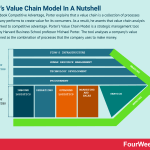

In his 1985 book Competitive Advantage, Porter explains that a value chain is a collection of processes that a company performs to create value for its consumers. As a result, he asserts that value chain analysis is directly linked to competitive advantage. Porter’s Value Chain Model is a strategic management tool developed by Harvard Business School professor Michael Porter. The tool analyses a company’s value chain – defined as the combination of processes that the company uses to make money.
Understanding Porter’s Value Chain modelPorter’s Value Chain model is a strategic management tool developed by Harvard Business School professor Michael Porter.
The tool analyses a company’s value chain – defined as the combination of processes that the company uses to make money.
In his 1985 book Competitive Advantage, Porter explains that a value chain is a collection of processes that a company performs to create value for its consumers. As a result, he asserts that value chain analysis is directly linked to competitive advantage.
Competitive advantage occurs when a business systematically examines its internal processes and how they interact with each other. Each process in the value chain should create value that exceeds the cost of creating that value. In other words, it should be profitable.
The strength of Porter’s model lies in its focus on customers through value chain systems. This is in contrast to other value chain models that focus on departmental and accounting expenses, for example.
The primary activities of Porter’s Value Chain modelPorter breaks down his value chain model into five primary processes or activities.
1. Inbound logisticsThis includes the warehousing and associated inventory control of raw materials. This also includes the nature of the relationship with suppliers.
2. OperationsOperations encompass any process that turns raw materials into a finished product ready for sale, including labeling, branding, and packaging.
3. Outbound logisticsOutbound logistics concern any process where the product is distributed to a customer. This includes the storage and distribution of products and the processes involved in fulfilling customer orders.
4. Marketing and salesAny processes that attempt to enhance product visibility among a target audience are included in marketing and sales. This activity is also heavily reliant on customer relationships.
5. ServicesServices include any processes that occur after a purchase has been made, including customer service, repairs, refunds, and warranty acknowledgment.
Secondary activitiesWithin Porter’s Value Chain model four secondary activities support the foundational primary activities common to most businesses.
Here is a brief look at each.
1. Company infrastructureCompany infrastructure entails any process that supports daily business operations. Administration, clerical, financial, and line management are all value-creating infrastructure processes.
2. Human resource managementHuman resource management (HRM) covers any process related to the training, acquisition, or termination of employees. HRM departments and their ability to hire talented and motivated staff are crucial to a company’s competitive advantage.
3. Research and developmentTechnology can create a competitive advantage in Porter’s value chain because it can streamline important processes. These include payroll automation software, customer service procedures, and distribution networks.
4. ProcurementProcurement is simply the acquisition of necessary goods or services. The most typical example is the procurement of raw materials and the negotiation of pricing and product purchase contracts. It may also include the purchase of equipment, offices, buildings, and machinery.
Starbucks and Porter’s value chain modelTo better understand the value chain concept, let’s take a look at the various value chain and secondary process activities using Starbucks as an example.
Value chain activitiesInbound logisticsThe Starbucks value chain begins with buyers purchasing high-quality coffee beans from primary producers in Asia, Africa, and Latin America. The beans are roasted and packaged – which adds value to their sale price – and sent to a mixture of Starbucks-owned and third-party distribution centers.
Note that the procurement process is never outsourced to ensure quality standards are enforced from the start of the chain.
OperationsStarbucks operates more than 32,000 stores in 80 different countries. Stores are either company-owned or licensed to other companies who have access to desirable retail spaces such those inside airports.
Starbucks also owns a range of related brands such as La Boulange, Teavana, Ethos Water, and Seattle Coffee Co.
Outbound logisticsStarbucks does not tend to employ a B2B model where other brands distribute its products, but a small selection of coffee products can be found in supermarkets.
Most products are transported from warehouses and distribution centers and then sold in Starbucks stores and cafés around the world.
Marketing and salesStarbucks is one of the world’s most recognizable brands, and for good reason. The company is able to promote its brand with consistent messaging across social media, video, television, events, and various in-store experiences such as new product sampling.
ServiceThe company aims to build brand loyalty through a superior in-store experience. After witnessing the café culture in Italy, CEO Howard Schultz wanted to bring a similar experience to American coffee lovers.
In a later interview, he wanted Starbucks to serve “as a third place between home and work, an extension between people’s lives, at a time when people have no place to go.” In addition to home-based comforts, Starbucks invests heavily in customer service training to add value to the chain.
Secondary process activitiesLet’s now take a look at the secondary process activities.
Company infrastructureThis encompasses various departments that are necessary to maintain company operations, such as finance and legal.
Starbucks also employs business managers in corporate offices and store managers in each café to oversee the baristas.
Human resource managementStarbucks is well known for its effective human resource management. Employees are offered a range of perks, including health coverage, paid leave, retirement plans, subsidized university education, company stock plans, and discounts on work-related transportation expenses.
These initiatives result in a motivated, efficient, and engaged workforce which increases employee retention.
Research and developmentEach Starbucks store provides unlimited bandwidth free of charge which creates significant value for casual diners and businessmen alike. The company also uses technology to ensure the taste of its coffee is consistent across its stores.
The Starbucks Rewards program app is another example of the café chain using technology to its advantage. Customers can download an app, use it to pay for their coffee, and collect stars that can be redeemed for food, drinks, and more. Customers must preload the app with money or redeem a gift card to make a purchase.
ProcurementAs we noted earlier, procurement for Starbucks means sourcing coffee beans directly from primary producers on several continents. Purchasing agents that are employed by the company form strategic partnerships with each producer and communicate the standards they must meet in terms of bean quality.
Key takeaways:Porter’s Value Chain model is a strategic management tool for the analysis of a company’s value chain.Porter’s Value Chain model is customer relationship-centric and is used by businesses to systematically examine each of their many processes for profitability. It is comprised of five primary value chain activities that are further supported by four secondary process activities.The value chain of Starbucks starts from the moment it sources beans from primary producers in various countries. Value is also added to the Starbucks in-store experience and consistent brand messaging.Read also: Business Strategy, Examples, Case Studies, And ToolsOther frameworks by Michael PorterPorter’s Five Forces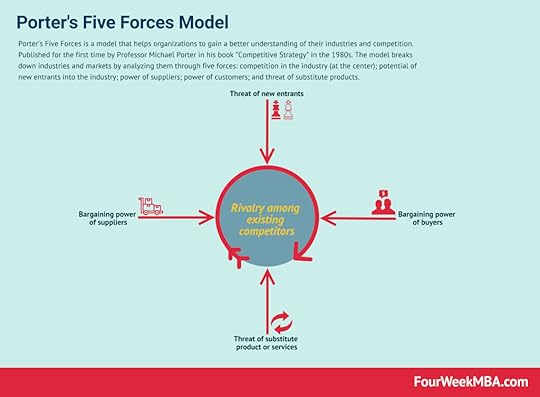 Porter’s Five Forces is a model that helps organizations to gain a better understanding of their industries and competition. Published for the first time by Professor Michael Porter in his book “Competitive Strategy” in the 1980s. The model breaks down industries and markets by analyzing them through five forcesPorter’s Generic Strategies
Porter’s Five Forces is a model that helps organizations to gain a better understanding of their industries and competition. Published for the first time by Professor Michael Porter in his book “Competitive Strategy” in the 1980s. The model breaks down industries and markets by analyzing them through five forcesPorter’s Generic Strategies
 In his book, “Competitive Advantage,” in 1985, Porter conceptualized the concept of competitive advantage, by looking at two key aspects. Industry attractiveness, and the company’s strategic positioning. The latter, according to Porter, can be achieved either via cost leadership, differentiation, or focus.Porter’s Diamond Model
In his book, “Competitive Advantage,” in 1985, Porter conceptualized the concept of competitive advantage, by looking at two key aspects. Industry attractiveness, and the company’s strategic positioning. The latter, according to Porter, can be achieved either via cost leadership, differentiation, or focus.Porter’s Diamond Model
 Porter’s Diamond Model is a diamond-shaped framework that explains why specific industries in a nation become internationally competitive while those in other nations do not. The model was first published in Michael Porter’s 1990 book The Competitive Advantage of Nations. This framework looks at the firm strategy, structure/rivalry, factor conditions, demand conditions, related and supporting industries.Porter’s Four Corners Analysis
Porter’s Diamond Model is a diamond-shaped framework that explains why specific industries in a nation become internationally competitive while those in other nations do not. The model was first published in Michael Porter’s 1990 book The Competitive Advantage of Nations. This framework looks at the firm strategy, structure/rivalry, factor conditions, demand conditions, related and supporting industries.Porter’s Four Corners Analysis
 Developed by American academic Michael Porter, the Four Corners Analysis helps a business understand its particular competitive landscape. The analysis is a form of competitive intelligence where a business determines its future strategy by assessing its competitors’ strategy, looking at four elements: drivers, current strategy, management assumptions, and capabilities.More Business FrameworksAnsoff Matrix
Developed by American academic Michael Porter, the Four Corners Analysis helps a business understand its particular competitive landscape. The analysis is a form of competitive intelligence where a business determines its future strategy by assessing its competitors’ strategy, looking at four elements: drivers, current strategy, management assumptions, and capabilities.More Business FrameworksAnsoff Matrix You can use the Ansoff Matrix as a strategic framework to understand what growth strategy is more suited based on the market context. Developed by mathematician and business manager Igor Ansoff, it assumes a growth strategy can be derived by whether the market is new or existing, and the product is new or existing.Blitzscaling Canvas
You can use the Ansoff Matrix as a strategic framework to understand what growth strategy is more suited based on the market context. Developed by mathematician and business manager Igor Ansoff, it assumes a growth strategy can be derived by whether the market is new or existing, and the product is new or existing.Blitzscaling Canvas The Blitzscaling business model canvas is a model based on the concept of Blitzscaling, which is a particular process of massive growth under uncertainty, and that prioritizes speed over efficiency and focuses on market domination to create a first-scaler advantage in a scenario of uncertainty.Blue Ocean Strategy
The Blitzscaling business model canvas is a model based on the concept of Blitzscaling, which is a particular process of massive growth under uncertainty, and that prioritizes speed over efficiency and focuses on market domination to create a first-scaler advantage in a scenario of uncertainty.Blue Ocean Strategy A blue ocean is a strategy where the boundaries of existing markets are redefined, and new uncontested markets are created. At its core, there is value innovation, for which uncontested markets are created, where competition is made irrelevant. And the cost-value trade-off is broken. Thus, companies following a blue ocean strategy offer much more value at a lower cost for the end customers.Business Analysis Framework
A blue ocean is a strategy where the boundaries of existing markets are redefined, and new uncontested markets are created. At its core, there is value innovation, for which uncontested markets are created, where competition is made irrelevant. And the cost-value trade-off is broken. Thus, companies following a blue ocean strategy offer much more value at a lower cost for the end customers.Business Analysis Framework Business analysis is a research discipline that helps driving change within an organization by identifying the key elements and processes that drive value. Business analysis can also be used in Identifying new business opportunities or how to take advantage of existing business opportunities to grow your business in the marketplace.Gap Analysis
Business analysis is a research discipline that helps driving change within an organization by identifying the key elements and processes that drive value. Business analysis can also be used in Identifying new business opportunities or how to take advantage of existing business opportunities to grow your business in the marketplace.Gap Analysis A gap analysis helps an organization assess its alignment with strategic objectives to determine whether the current execution is in line with the company’s mission and long-term vision. Gap analyses then help reach a target performance by assisting organizations to use their resources better. A good gap analysis is a powerful tool to improve execution.Business Model Canvas
A gap analysis helps an organization assess its alignment with strategic objectives to determine whether the current execution is in line with the company’s mission and long-term vision. Gap analyses then help reach a target performance by assisting organizations to use their resources better. A good gap analysis is a powerful tool to improve execution.Business Model Canvas The business model canvas is a framework proposed by Alexander Osterwalder and Yves Pigneur in Busines Model Generation enabling the design of business models through nine building blocks comprising: key partners, key activities, value propositions, customer relationships, customer segments, critical resources, channels, cost structure, and revenue streams.Lean Startup Canvas
The business model canvas is a framework proposed by Alexander Osterwalder and Yves Pigneur in Busines Model Generation enabling the design of business models through nine building blocks comprising: key partners, key activities, value propositions, customer relationships, customer segments, critical resources, channels, cost structure, and revenue streams.Lean Startup Canvas The lean startup canvas is an adaptation by Ash Maurya of the business model canvas by Alexander Osterwalder, which adds a layer that focuses on problems, solutions, key metrics, unfair advantage based, and a unique value proposition. Thus, starting from mastering the problem rather than the solution.Digital Marketing Circle
The lean startup canvas is an adaptation by Ash Maurya of the business model canvas by Alexander Osterwalder, which adds a layer that focuses on problems, solutions, key metrics, unfair advantage based, and a unique value proposition. Thus, starting from mastering the problem rather than the solution.Digital Marketing Circle A digital channel is a marketing channel, part of a distribution strategy, helping an organization to reach its potential customers via electronic means. There are several digital marketing channels, usually divided into organic and paid channels. Some organic channels are SEO, SMO, email marketing. And some paid channels comprise SEM, SMM, and display advertising.
A digital channel is a marketing channel, part of a distribution strategy, helping an organization to reach its potential customers via electronic means. There are several digital marketing channels, usually divided into organic and paid channels. Some organic channels are SEO, SMO, email marketing. And some paid channels comprise SEM, SMM, and display advertising.More resources:
What Is Business Model InnovationWhat Is a Business ModelWhat Is a Value PropositionWhat Is Market SegmentationWhat Is a Marketing StrategyThe post What is Porter’s Value Chain Model And Why It Matters In Business appeared first on FourWeekMBA.
What Is The Lasswell Communication Model? The Lasswell Communication Model In A Nutshell
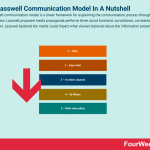

The Lasswell communication model is a linear framework for explaining the communication process through segmentation. Lasswell proposed media propaganda performs three social functions: surveillance, correlation, transmission. Lasswell believed the media could impact what viewers believed about the information presented.
Understanding the Lasswell communication modelThe Lasswell communication model is named after American political scientist and communication theorist Harold Lasswell.
Lasswell, a former Yale University professor, developed the model in 1948 to analyze mass communication and the effect of media propaganda in various countries and businesses. To that end, he proposed media propaganda performs three social functions:
Surveillance – which gives those consuming media insight into what is transpiring around them.Correlation – this refers to the media’s interpretation and explanation of specific news events.Transmission – where the media conveys social ideas and cultural heritage to subsequent generations of media consumers.In general terms, Lasswell believed the media could impact what viewers believed about the information presented. This notion can be extended to any communicator, whether it be a person, group, or business.
Regardless of the context, however, the communicating entity has some intention to influence the receiver through messaging. This means Lasswell’s model treats communication as a tool for persuasion.
The five components of the Lasswell communication modelFive components can be used to predict the effect a message has on a person or group of people, with each having its own analysis method.
Let’s take a look at the five components below:
1 – WhoThe communicator, sender, or source of the message. This may be a person or an organized institution like a newspaper, radio station, website, or television station.
Here, Lasswell argued that a control analysis should be used to critique the sender on how they exercise control and power over the message being disseminated. Do they have authority on the topic? Do they have a political agenda or some other bias? How have they reported on similar events in the past?
2 – Says whatPut simply, the message being communicated. This may include a news story, fairy-tale, biblical story, political story, or story with an important take-home message.
In this case, Lasswell favored a content analysis where a transcription of the message is scrutinized. This enables the receiver to identify recurring themes, highlight important passages, and identify how the message distorts the truth.
More specifically:
How does the message depict someone as a hero while depicting someone else as a villain? How does it frame the battle between good and evil?How are minority groups portrayed? This is an increasingly important factor.What are the concepts being reinforced as the ideal or truth?3 – In which channelThis describes the medium or media used to disseminate the message, such as social media, photography, books, blogs, television, radio, letters, and magazines.
When Lasswell developed his theory in 1948, he had access to a very small number of media. But the premise remains the same today, with a media analysis determining the medium most suitable for sending a message to a particular audience.
4 – To WhomThis is the receiver of the message, which may be an individual or an audience. In the context of mass communication, the audience may constitute:
The citizens of a nation.The readership of a blog, magazine, or newspaper.Children – if messages are being sent on television before and after school and on weekends.Adults – for products such as alcohol and gambling.Women – for the promotion of women’s fashion and related social issues.In the fourth component, audience analysis is key. This categorizes the preferences of audiences according to:
Demography – age, income level, ethnicity, location, and marital status.Status – political or social affiliations, job titles, and professions.Behaviors – needs, wants, values, hobbies, personalities.5 – With what effectWhat effect will the message have on the intended target audience?
In marketing, the effect the business wants to institute is consumers spending money. However, other effects may also include influencing voter preferences, increased brand awareness, or public awareness of a health issue.
To measure the impact of a message, an effects analysis is undertaken. For modern businesses, results can be attained almost instantaneously. An eCommerce business will know how long a consumer spends on their site before purchasing. Similarly, it will also be able to determine the success of a recent advertising campaign and be able to make important strategic adjustments.
Advantages and disadvantages of the Lasswell model of communicationAdvantagesVersatilityLasswell’s model is useful to describe almost any type of communication, irrespective of the context, message content, sender and receiver, and medium in which the communication occurs.
SimplicityWhile it does not have the nuance of some other models, many enjoy Lasswell’s interpretation because it is simple, easy to understand, and contains only five components.
DisadvantagesFeedbackThe main criticism of Lasswell’s model is that it does not account for feedback. While the effect a message has on the receiver could be construed as feedback, Lasswell’s model was intended to study mass media communication. As a result, it does not consider that the receiver may want to transmit a message back to the sender.
NoiseFurthermore, Lasswell’s model does not consider the impact of noise. This can be defined as any internal or external factor that disrupts the communication process. In general, noise may be physiological (hunger, fatigue), physical (interference, static, a passing train), psychological (preoccupation, inattentiveness), and semantic – where words or concepts are not mutually understood because of age, culture, experience, or some other factor.
Common misconceptions of Lasswell’s modelLasswell’s model has existed for over 70 years. During that time, several misconceptions have arisen and cast doubt over Lasswell’s contribution to the field of mass communication.
Let’s take a brief look at these misconceptions below.
The model is static with fixed categoriesMany assume Lasswell’s model is a product of its time. Post-World War Two, communication was mechanistic and consisted of one sender, a broadcast message, and many receivers.
However, in the years after his model was released, Lasswell stressed that his model could be adapted to a range of contexts. In 1968, for example, he noted that it could be used to analyze political discourse and added several more components. In the late 1990s, several scholars also equated “effect” with “feedback” and used it in various social, economic, and cultural contexts.
Lasswell created a graphical modelThere is also an assumption that Lasswell created the graphical model behind his theory. However, it was first mentioned by Denis Mcquail and Sven Windahl in their 1981 book Communication Models for the Study of Mass Communications.
Further analysis of the model and how it was applied to Lasswell’s theory has discovered potential inconsistencies. Perhaps the most salient is that Mcquail and Windahl used arrows pointing from left to right to give the impression of linear communication. However, experts argue that Lasswell’s categories of questions are just that. There is nothing in the theory suggesting communication must progress through the categories linearly.
Lasswell’s model is outdatedSome also consider Lasswell’s model outdated for obvious reasons. But when the theory is perceived as more than a simple linear model and instead as a general concept, we discover that it has more utility and relevance today.
This can be demonstrated by the way in which Lasswell’s concept has been cited in literature over the past few decades. Indeed, it has been adapted as a maxim, index, model, formula, paradigm, and dictum, among other uses.
Key takeaways:The Lasswell communication model is a linear framework for explaining the communication process through segmentation. It was developed by American political scientist and communication theorist Harold Lasswell in 1948.The Lasswell communication model was based on a study of media propaganda across various countries and businesses and the role it played in mass communication.The Lasswell communication model is comprised of five components, with each component asking the receiver to critically analyze various aspects of the message.Main Free Guides:
Business ModelsBusiness StrategyBusiness DevelopmentDigital Business ModelsDistribution ChannelsMarketing StrategyPlatform Business ModelsTech Business ModelThe post What Is The Lasswell Communication Model? The Lasswell Communication Model In A Nutshell appeared first on FourWeekMBA.
What Is The EPRG Framework? EPRG Framework In A Nutshell
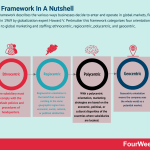

The EPRG framework describes the various ways businesses decide to enter and operate in global markets, first introduced in 1969 by globalization expert Howard V. Perlmutter this framework categorizes four orientations or approaches to global marketing and staffing: ethnocentric, regiocentric, polycentric, and geocentric.
Understanding the EPRG frameworkThe EPRG framework describes the various ways businesses decide to enter and operate in global markets.
The EPRF framework was first introduced by globalization expert Howard V. Perlmutter in a 1969 journal article entitled The Tortuous Evolution of Multinational Enterprises.
Perlmutter argued that the way a company responds to global market opportunities depends on the assumptions management holds about the nature of international marketing. These assumptions, which Perlmutter called orientations, dictate how a company manages operations between the headquarters in its home country and its foreign subsidiaries.
The EPRG framework categorizes global marketing strategies according to four orientations which describe various approaches to global staffing. We will take a look at each of these in more detail in the following sections.
Ethnocentric orientationHere, the subsidiary must comply with the default policies and procedures of headquarters. This means the company does not adapt its products to the needs or wants of the other countries they operate in. There are no changes in product specification, price, or promotional strategy.
Essentially, management believes that employees native to the home market can do a better job driving the company forward overseas than their non-native counterparts. An ethnocentric orientation may also arise naturally because of a shortage of expertise in a foreign country.
Ethnocentric orientation can lead to problems in foreign markets. When Nissan exported cars to the United States, many vehicles failed to start in the much colder North American winters. Nissan also made the mistake of assuming drivers would place a blanket over the engine to warm it up – which is what citizens in the freezing north of Japan were accustomed to.
Ethnocentric orientation benefitsCoordination – the lack of variation in employee backgrounds results in more coordination between company headquarters and the foreign country.Cost-effectiveness – since there is very little change in terms of product features, price, or promotional strategies, the business can avoid the expenses associated with adapting products for various international markets.Expansion capacity – the ethnocentric orientation may also be used by companies that are making their first foray into other countries. The approach allows them to establish new production facilities and launch products with relative ease.Regiocentric orientationRegiocentric orientation is the belief that countries existing in the same geographic region have economic, social, cultural, or political similarities. As a result, the strategies developed for one country are effective when deployed throughout.
Coca-Cola has used regiocentric orientation to market its carbonated beverages in the sub-continent region consisting of the Indian, Pakistani, and Bangladeshi markets.
Regiocentric orientation benefitsEffectivenessThe regiocentric approach occupies a favorable middle ground between the more specific polycentric orientation and the more general ethnocentric and geocentric approaches. Companies tend to be more effective since they can cater to broader audiences across multiple countries without the inherent inefficiencies of catering to smaller or more localized consumer groups.
Cultural fitRecruiting employees from specific regions can offer a better cultural fit than taking a more general approach to recruitment. For example, companies operating in North Africa and the Middle East would be able to hire individuals with an Arab background who are more likely to share the same cultural values. For example, most Arabs are Muslims and speak some degree of classical Arabic. Cultural fit also has the flow-on effect of reducing the costs associated with employee onboarding. What’s more, it reduces the likelihood that an employee will experience culture shock and leave their role within the company.
Polycentric orientationWith a polycentric orientation, marketing strategies are based on the economic, political, or cultural disparities of the countries where subsidiaries are located. Polycentrism is the opposite of ethnocentrism in that the business seeks to do things the way locals do.
McDonald’s is perhaps the best example of polycentrism in action because its restaurants are sensitive to the peculiarities of different markets. In India, McDonald’s serves vegetarian food because Indian citizens view cows as sacred. In France, Germany, and Portugal, restaurants serve wine in addition to soft drinks.
Polycentric orientation benefitsIncreased salesCompanies such as McDonald’s that take the time to understand the host market are likely to be more successful as a result. Consumers in these markets tend to favor international brands that are sensitive to their cultural and societal values and beliefs.
Motivated workforceBy the same token, a local workforce whose values are understood and respected are more likely to be happy and motivated employees who have a vested interest in helping the company succeed.
Third-world applicationThe polycentric orientation is ideal for companies looking to expand into developing or third-world nations. Most of these nations are characterized by financial, legal, political, or cultural constraints.
Geocentric orientationGeocentric orientation means the company sees the whole world as a potential market. In other words, they see a negligible difference between countries because consumers have more or less the same needs. While differences do exist in reality, the geocentric approach assumes most differences will be forgotten or accepted by the target audience.
Given there are no explicit barriers between the headquarters and its subsidiaries, it can be expensive and challenging to overcome discrepancies in labor standards and customer preferences. However, with a unified strategy, this orientation rewards the significant investment by making the firm more agile and responsive to change.
American cable channel MTV is seen all around the world but there is little difference in how the channel is branded or presented. Each channel is named after the country it operates in, such as MTV India, MTV Korea, and MTV China.
Geocentric orientation benefits:Global expertiseThose with a geocentric orientation tend to be large corporations with similarly large ambitions. To achieve their goals, these corporations can establish a pool of senior executives with industry experience and contacts around the world. Employees are hired based on their skills and abilities and not on their physical location.
AgilityWith a core, unified strategy and an assembled team of competent individuals, the geocentric orientation enables companies to be more agile and responsive to change. Agility is also increased since there are rarely language or cultural barriers to overcome between different regions.
Easier executionIn general, the geocentric orientation is also easier to execute since there is one strategy and not several more intricate strategies. Many companies will simply replicate their domestic strategies abroad with very little customization. While less sensitive to specific cultural needs, this approach is more cost-effective.
Key takeaways:The EPRG framework describes the various ways businesses decide to enter and operate in global markets. The concept was first introduced in 1969 by globalization expert Howard V. Perlmutter.Fundamental to the EPRG framework is how a company manages the relationship between its headquarters and foreign subsidiaries.The EPRG framework categories four orientations or approaches to global marketing and staffing: ethnocentric, regiocentric, polycentric, and geocentric.Other connected business strategy frameworksPESTEL Analysis The PESTEL analysis is a framework that can help marketers assess whether macro-economic factors are affecting an organization. This is a critical step that helps organizations identify potential threats and weaknesses that can be used in other frameworks such as SWOT or to gain a broader and better understanding of the overall marketing environment.STEEP Analysis
The PESTEL analysis is a framework that can help marketers assess whether macro-economic factors are affecting an organization. This is a critical step that helps organizations identify potential threats and weaknesses that can be used in other frameworks such as SWOT or to gain a broader and better understanding of the overall marketing environment.STEEP Analysis The STEEP analysis is a tool used to map the external factors that impact an organization. STEEP stands for the five key areas on which the analysis focuses: socio-cultural, technological, economic, environmental/ecological, and political. Usually, the STEEP analysis is complementary or alternative to other methods such as SWOT or PESTEL analyses.STEEPLE Analysis
The STEEP analysis is a tool used to map the external factors that impact an organization. STEEP stands for the five key areas on which the analysis focuses: socio-cultural, technological, economic, environmental/ecological, and political. Usually, the STEEP analysis is complementary or alternative to other methods such as SWOT or PESTEL analyses.STEEPLE Analysis The STEEPLE analysis is a variation of the STEEP analysis. Where the step analysis comprises socio-cultural, technological, economic, environmental/ecological, and political factors as the base of the analysis. The STEEPLE analysis adds other two factors such as Legal and Ethical.Porter’s Five Forces
The STEEPLE analysis is a variation of the STEEP analysis. Where the step analysis comprises socio-cultural, technological, economic, environmental/ecological, and political factors as the base of the analysis. The STEEPLE analysis adds other two factors such as Legal and Ethical.Porter’s Five Forces
 Porter’s Five Forces is a model that helps organizations to gain a better understanding of their industries and competition. Published for the first time by Professor Michael Porter in his book “Competitive Strategy” in the 1980s. The model breaks down industries and markets by analyzing them through five forces.SWOT Analysis
Porter’s Five Forces is a model that helps organizations to gain a better understanding of their industries and competition. Published for the first time by Professor Michael Porter in his book “Competitive Strategy” in the 1980s. The model breaks down industries and markets by analyzing them through five forces.SWOT Analysis
 A SWOT Analysis is a framework used for evaluating the business’s Strengths, Weaknesses, Opportunities, and Threats. It can aid in identifying the problematic areas of your business so that you can maximize your opportunities. It will also alert you to the challenges your organization might face in the future.BCG Matrix
A SWOT Analysis is a framework used for evaluating the business’s Strengths, Weaknesses, Opportunities, and Threats. It can aid in identifying the problematic areas of your business so that you can maximize your opportunities. It will also alert you to the challenges your organization might face in the future.BCG Matrix
 In the 1970s, Bruce D. Henderson, founder of the Boston Consulting Group, came up with The Product Portfolio (aka BCG Matrix, or Growth-share Matrix), which would look at a successful business product portfolio based on potential growth and market shares. It divided products into four main categories: cash cows, pets (dogs), question marks, and stars.Balanced Scorecard
In the 1970s, Bruce D. Henderson, founder of the Boston Consulting Group, came up with The Product Portfolio (aka BCG Matrix, or Growth-share Matrix), which would look at a successful business product portfolio based on potential growth and market shares. It divided products into four main categories: cash cows, pets (dogs), question marks, and stars.Balanced Scorecard
 First proposed by accounting academic Robert Kaplan, the balanced scorecard is a management system that allows an organization to focus on big-picture strategic goals. The four perspectives of the balanced scorecard include financial, customer, business process, and organizational capacity. From there, according to the balanced scorecard, it’s possible to have a holistic view of the business.Blue Ocean Strategy
First proposed by accounting academic Robert Kaplan, the balanced scorecard is a management system that allows an organization to focus on big-picture strategic goals. The four perspectives of the balanced scorecard include financial, customer, business process, and organizational capacity. From there, according to the balanced scorecard, it’s possible to have a holistic view of the business.Blue Ocean Strategy
 A blue ocean is a strategy where the boundaries of existing markets are redefined, and new uncontested markets are created. At its core, there is value innovation, for which uncontested markets are created, where competition is made irrelevant. And the cost-value trade-off is broken. Thus, companies following a blue ocean strategy offer much more value at a lower cost for the end customers.Scenario Planning
A blue ocean is a strategy where the boundaries of existing markets are redefined, and new uncontested markets are created. At its core, there is value innovation, for which uncontested markets are created, where competition is made irrelevant. And the cost-value trade-off is broken. Thus, companies following a blue ocean strategy offer much more value at a lower cost for the end customers.Scenario Planning
 Businesses use scenario planning to make assumptions on future events and how their respective business environments may change in response to those future events. Therefore, scenario planning identifies specific uncertainties – or different realities and how they might affect future business operations. Scenario planning attempts at better strategic decision making by avoiding two pitfalls: underprediction, and overprediction.
Businesses use scenario planning to make assumptions on future events and how their respective business environments may change in response to those future events. Therefore, scenario planning identifies specific uncertainties – or different realities and how they might affect future business operations. Scenario planning attempts at better strategic decision making by avoiding two pitfalls: underprediction, and overprediction.Main Free Guides:
Business ModelsBusiness StrategyBusiness DevelopmentDigital Business ModelsDistribution ChannelsMarketing StrategyPlatform Business ModelsTech Business ModelThe post What Is The EPRG Framework? EPRG Framework In A Nutshell appeared first on FourWeekMBA.
January 28, 2022
What Are An Accelerator And An Incubator? Accelerator vs. Incubator In A Nutshell
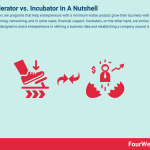
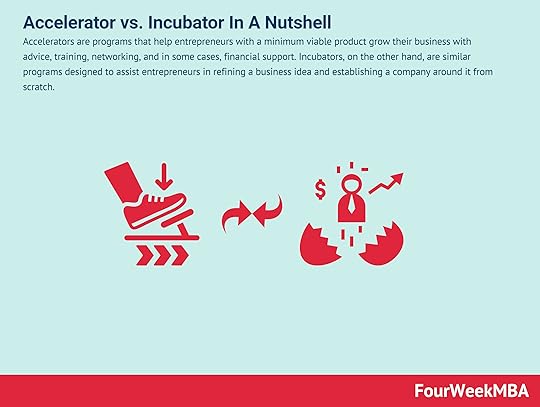
Accelerators are programs that help entrepreneurs with a minimum viable product grow their business with advice, training, networking, and in some cases, financial support. Incubators, on the other hand, are similar programs designed to assist entrepreneurs in refining a business idea and establishing a company around it from scratch.
Understanding acceleratorsA startup accelerator describes an organization that provides mentorship, capital, and access to a network of business partners and investors for startups with a validated minimum viable product (MVP). To that end, accelerator programs are well suited to companies with potential as a way to rapidly scale growth.
Examples of companies that run accelerator programs include Y Combinator, Techstars, and MassChallenge. The acceptance rate for such programs is low as there are thousands of startups applying for a finite amount of resources. Successful applicants will be required to hand over equity in their companies to the accelerator in exchange for services rendered.
Since the overarching goal is to scale growth rapidly, accelerators tend to be intense programs lasting anywhere between three and six months.
Understanding incubatorsA startup incubator has a core focus on nurturing entrepreneurs in a collaborative and supportive environment. Incubator programs assist when required in various areas and as a consequence, do not tend to operate on a fixed schedule. The primary purpose of an incubator is to provide real-world context to the theories an entrepreneur may have learned as part of their tertiary education.
For instance, some will need assistance with their product-market fit while others need help making their business more attractive to investors. Incubators also enable startup founders to network with the founders of other startups in the same program.
Many incubator companies specialize in specific verticals. Monarq Incubator specializes in female-centric startups while KitchenCru is a food or kitchen incubator that provides commercial kitchen space and insurance, banking, and marketing assistance to budding culinary entrepreneurs.
Key differences between accelerators and incubatorsNow that we have explained each type of program, let’s take a look at some of the main differences:
Accelerators, as the name suggests, aim to accelerate the growth of a company via rapid scaling. Conversely, incubators focus on “incubating” disruptive ideas and many consider them preparation for a subsequent accelerator program.Accelerators have a specific timeframe since resources such as capital, office space, and mentorship services are finite. There is less emphasis on material resources in an incubator program, so they may last for months or even several years.Mentorship in exchange for equity in the company is one of the reasons accelerator programs are so popular with entrepreneurs. However, this makes the application process much more rigorous and selective than in an incubator where there is more of a relaxed attitude to the selection process.Incubators tend to be independent companies that are sponsored by universities, governments, development corporations, and non-profit organizations. In contrast, accelerators are more likely to be funded by private organizations.Key takeaways:Accelerators programs help entrepreneurs with an MVP grow their business with advice, training, networking, and in some cases, financial support. Incubators, on the other hand, are designed to assist entrepreneurs in refining a business idea and establishing a company around it from the ground up.Accelerator programs tend to be intense and last anywhere between 3-6 months, while incubator programs focus on creating a more relaxed, collaborative work environment that may last for several months or years.Due to demand and finite resources, the application process for an accelerator program is much more rigorous and selective than an incubator. Incubators are normally sponsored by non-profits, governments, and other development organizations.Main Free Guides:
Business ModelsBusiness CompetitionBusiness StrategyBusiness DevelopmentDigital Business ModelsDistribution ChannelsMarketing StrategyPlatform Business ModelsRevenue ModelsTech Business ModelsBlockchain Business Models FrameworkConnected ConceptsVenture Capital A venture capitalist generally invests in companies and startups which are still in a stage where their business model needs to be proved viable, or they need resources to scale up. Thus, those companies present high risks, but the potential for exponential growth. Therefore, venture capitalists look for startups that can bring a high ROI and high valuation multiples.Economic Moat
A venture capitalist generally invests in companies and startups which are still in a stage where their business model needs to be proved viable, or they need resources to scale up. Thus, those companies present high risks, but the potential for exponential growth. Therefore, venture capitalists look for startups that can bring a high ROI and high valuation multiples.Economic Moat Economic or market moats represent the long-term business defensibility. Or how long a business can retain its competitive advantage in the marketplace over the years. Warren Buffet who popularized the term “moat” referred to it as a share of mind, opposite to market share, as such it is the characteristic that all valuable brands have.Meme Investing
Economic or market moats represent the long-term business defensibility. Or how long a business can retain its competitive advantage in the marketplace over the years. Warren Buffet who popularized the term “moat” referred to it as a share of mind, opposite to market share, as such it is the characteristic that all valuable brands have.Meme Investing Meme stocks are securities that go viral online and attract the attention of the younger generation of retail investors. Meme investing, therefore, is a bottom-up, community-driven approach to investing that positions itself as the antonym to Wall Street investing. Also, meme investing often looks at attractive opportunities with lower liquidity that might be easier to overtake, thus enabling wide speculation, as “meme investors” often look for disproportionate short-term returns.Payment for Order Flow
Meme stocks are securities that go viral online and attract the attention of the younger generation of retail investors. Meme investing, therefore, is a bottom-up, community-driven approach to investing that positions itself as the antonym to Wall Street investing. Also, meme investing often looks at attractive opportunities with lower liquidity that might be easier to overtake, thus enabling wide speculation, as “meme investors” often look for disproportionate short-term returns.Payment for Order Flow Payment for order flow consists of a “kickback” or commission that the broker routing customers to a market maker (in charge of enabling the bid and ask price) will pay a commission to the broker as a sort of market-making fee.What is a SPAC
Payment for order flow consists of a “kickback” or commission that the broker routing customers to a market maker (in charge of enabling the bid and ask price) will pay a commission to the broker as a sort of market-making fee.What is a SPAC A special purpose acquisition company (SPAC) is a company with no commercial operations that are created to raise capital through an IPO to acquire another company. The SPAC is also called for that reason a “blank check company” as it will use the money provided by investors to enable private companies to go public via the SPAC.
A special purpose acquisition company (SPAC) is a company with no commercial operations that are created to raise capital through an IPO to acquire another company. The SPAC is also called for that reason a “blank check company” as it will use the money provided by investors to enable private companies to go public via the SPAC.The post What Are An Accelerator And An Incubator? Accelerator vs. Incubator In A Nutshell appeared first on FourWeekMBA.



